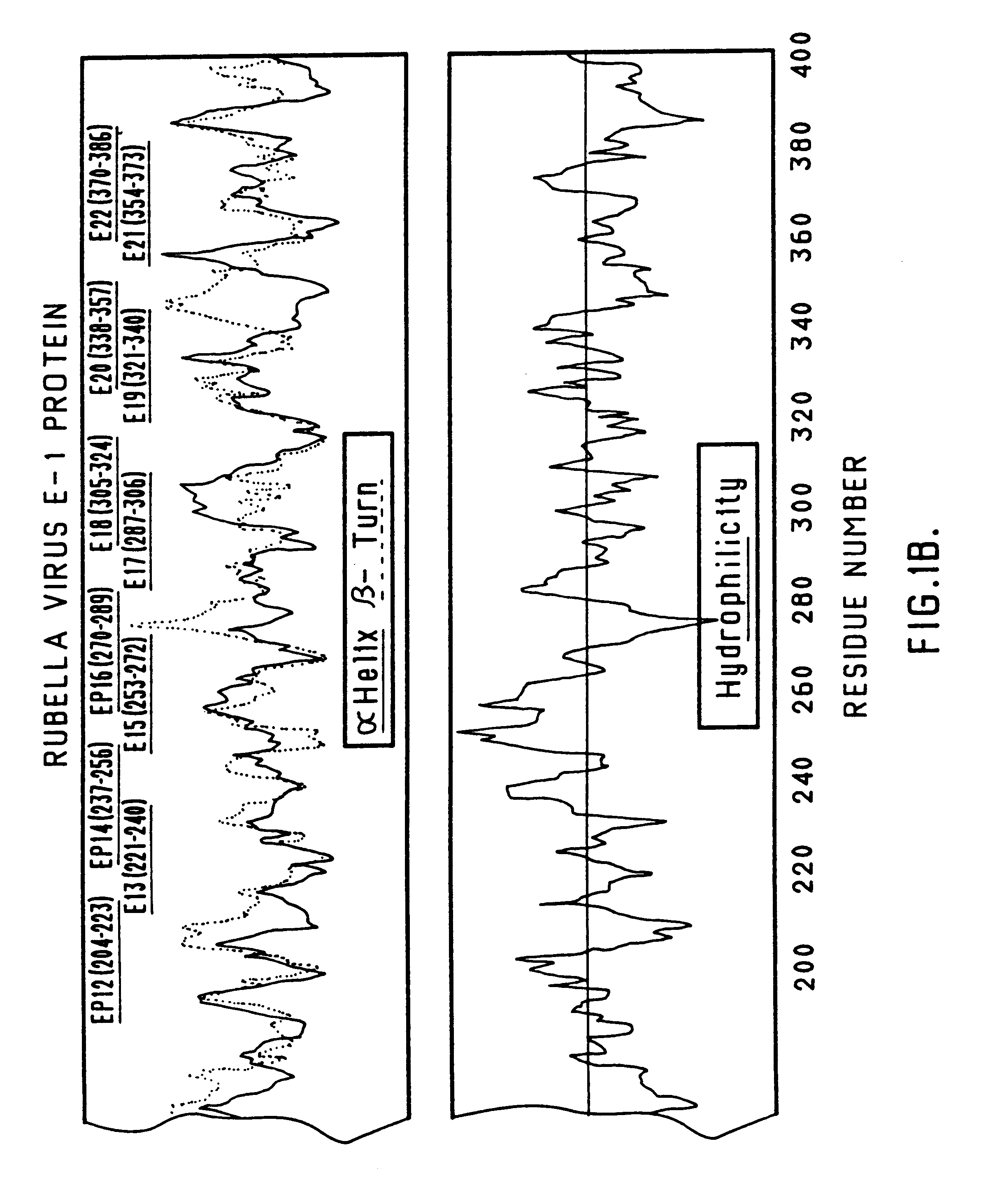Synthetic peptides for rubella vaccine
a technology of synthetic peptides and rubella virus, which is applied in the direction of virus peptides, biochemistry apparatus and processes, peptide sources, etc., can solve the problems of difficult purification of structural proteins, low titer of rubella virus, and inappropriate e1 neutralization epitopes
- Summary
- Abstract
- Description
- Claims
- Application Information
AI Technical Summary
Benefits of technology
Problems solved by technology
Method used
Image
Examples
example 1
This Example illustrates the preparation of rubella virus.
The RV strain M33 (ATCC, VR-315) was grown in Vero cells and isolated from the culture supernatant as described previously (ref. 10). The virus pellets were resuspended in a small volume of PBS and stored at -70.degree. C. The virus stock was titrated in RK 13 cells using an immunocytochemical focus assay modified from the methods described by Fukuda, Okuno and Waxham et al. (ref. 14,39,50). The virus stock (5.times.10.sup.7 focus forming units [FFU] / mL) was inactivated by UV-light (254 nm Model UVG-54 UV Products Inc.) for 10 minutes before use.
example 2
This Example illustrates peptide synthesis.
Peptides were synthesized in an automated ABI 430A peptide synthesizer using the solid-phase method (ref. 31). Fifty-four peptides covering most of the sequences of rubella viral structural proteins were synthesized. In some peptides, an additional cysteine residue as indicated by the notation (C) in the Tables) was added either at the N-terminal or the C-terminal and for coupling purposes. Synthetic peptides were cleaved from the resin by HF, and purified by reversed-phase high-pressure liquid chromatography using a Vydac C4 column. The purity of all peptide preparations exceeded 95%. For all peptides, amino acid analyses were performed on a Waters Pico-Tag system and found to be in good agreement with the theoretical compositions.
example 3
This Example illustrates generation of RV-specific monoclonal antibodies (MAbs).
Four week old Balb / C mice were immunized by intraperitoneal injection of purified rubella virus strain RA-27 / 3 (500 haemagglutinin (HA) units / dose / mouse) in complete Freund's adjuvant (CFA). Five 250 HA units / mouse were administered within 3 week intervals. Finally, 500 HA units / dose / mouse in saline were administered 3 days before fusion. Immune spleen cells were fused with NS-1 myeloma cells using polyethylene glycol 1500 (ref. 15). Supernatants were screened for the presence of rubella-specific antibodies by ELISA, and cells from positive wells were subsequently cloned twice by single cell dilution cloning. Each hybridoma cell line was expanded and seed stocks were stored in liquid nitrogen. Ascites were generated from mice inoculated with hybridoma cells that secreted RV-specific MAbs. Antibodies from ascites fluids were purified using the Bio-Rad Affi-gel protein A MAPS II system. The subclass of the...
PUM
| Property | Measurement | Unit |
|---|---|---|
| concentration | aaaaa | aaaaa |
| pH | aaaaa | aaaaa |
| pH | aaaaa | aaaaa |
Abstract
Description
Claims
Application Information
 Login to View More
Login to View More - R&D
- Intellectual Property
- Life Sciences
- Materials
- Tech Scout
- Unparalleled Data Quality
- Higher Quality Content
- 60% Fewer Hallucinations
Browse by: Latest US Patents, China's latest patents, Technical Efficacy Thesaurus, Application Domain, Technology Topic, Popular Technical Reports.
© 2025 PatSnap. All rights reserved.Legal|Privacy policy|Modern Slavery Act Transparency Statement|Sitemap|About US| Contact US: help@patsnap.com



